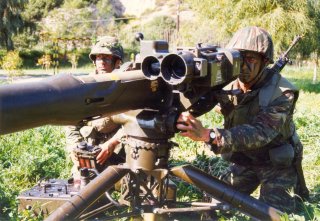For Syria and Beyond: How Iran Built Its Own TOW Anti-Tank Missile
Before the 1979 Iranian Revolution, both the United States and Iran were on friendly terms—so friendly in fact, the U.S. decided to allow Iran to import TOW anti-tank missiles.
Here's What You Need to Know: Iran excels at replicating foreign tech, especially for platforms that Iran would otherwise struggle to produce domestically—like high-end tanks and airframes. The TOW/Toophan is no exception, though in this case, Iran’s manufacturing base seems to have found a winning formula and created something that may in some ways be better than the original.
Anti-revolutionary Allies
Before the 1979 Iranian Revolution, both the United States and Iran were on friendly terms—so friendly in fact, the U.S. decided to allow Iran to import TOW anti-tank missiles. Iran gladly did, and even had TOW repair facilities built to service the TOW missile and its launchers. The Revolution spoiled Iran’s relations with the U.S.—but Iran already had the technology it needed to maintain and grow its American-made arsenal.
The TOW, and the Toophan copy are wire-guided missiles that are not fire-and-forget missiles, but need to be aimed at their target for the duration of flight.
At War
During the Iran-Iraq War, Iraqi armor suffered significant losses thanks to American TOWs. Though Iran attempted to manufacture reverse-engineered copies of the TOW, they did not preform as well as their American parent, which were prized for their effective anti-armor capabilities. By the 1990s however, the Iranian TOW copy was in business.
Like the TOW, the Toophan has evolved steadily since introduction, with later variants having increase range and armor penetration. Some even have a tandem warhead to defeat modern explosive-reactive armor paneling. The Toophan comes with a large tripod that is essentially indistinguishable from the TOW. In fact, the Iranian TOW copy is supposedly so similar, the launcher and ammunition can be used interchangeably with genuine TOW systems, and vice-versa.
Toophan
According to CSIS, the Toophan is optically tracked and wire guided, with an 8-pound or approximately 3.5 kilogram warhead and a range of 2 miles. Thanks to Iran’s extensive client-state network thought the Middle East, Toophan missiles have seen combat service in Syria, Yemen, and Iraq with Shiite militias where they’ve done a number on many tanks.
There have been quite a few variants of the Toophan missile in production in Iran. One of the most advanced variants is said to forgo the TOW’s wire guidance system in favor of laser-guidance, and a tandem-warhead arrangement for punching through more modern armor. According to the Iranian PressTV, the Toophan 5 as this variant is known, is also resistant to electronic jamming, since it essentially “rides” a laser to target, rather than depending on radio guidance.
In addition to enemy armor, the Toophan can also target low and slow enemy aircraft like turboprops or helicopters, and there are apparently a couple Toophan variants that can be used in an anti-bunker role rather than for targeting enemy armor.
As I previously wrote, Iran excels at replicating foreign tech, especially for platforms that Iran would otherwise struggle to produce domestically—like high-end tanks and airframes. The TOW/Toophan is no exception, though in this case, Iran’s manufacturing base seems to have found a winning formula and created something that may in some ways be better than the original.
Caleb Larson holds a Master of Public Policy degree from the Willy Brandt School of Public Policy. He lives in Berlin and writes on U.S. and Russian foreign and defense policy, German politics, and culture.
This article first appeared in May 2020.
Image: Wikipedia.

